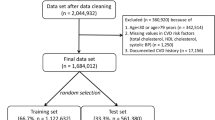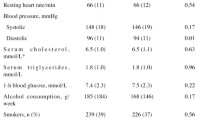Abstract
While assessment of global cardiovascular risk is uniformly recommended for risk factor management, prediction of all-cause death has seldom been considered in available charts. We established an updated algorithm to predict absolute 10-year risk of all-cause mortality in apparently healthy subjects living in France, a country with high life expectancy. Analyses were based on the Third French MONICA Survey on cardiovascular risk factors (1995–1996) carried out in 3,208 participants from the general population aged 35–64. Vital status was obtained 10 years after inclusion and assessment of determinants of mortality was based on multivariable Cox modelling. One-hundred-fifty-six deaths were recorded. Independent determinants of mortality were living area (Northern France), older age, male gender, no high-school completion, smoking, systolic blood pressure ≥ 160 mmHg, LDL-cholesterol ≥ 5.2 mmol/l, and diabetes. Score sheets were developed to easily estimate 10-year risk of death. For example, a non diabetic, heavy smoker, 46-year old man, living in South-Western France, who did not complete high-school, with LDL-cholesterol ≥ 5.2 mmol/l and systolic blood pressure < 160 mmHg, has a 17% probability of death in the ten coming years. The C-statistic of the prediction model was 0.76 [95% CI: 0.72–0.80] with a degree of overoptimism estimated at 0.0058 in a bootstrap sample. Calibration was satisfying: P value for Hosmer–Lemeshow χ2 test was 0.483. This prediction algorithm is a simple tool for guiding practitioners towards a more or less aggressive management of risk factors in apparently healthy subjects.

Similar content being viewed by others
Abbreviations
- CI:
-
Confidence intervals
- HDL-cholesterol:
-
High density lipoprotein cholesterol
- HRs:
-
Hazard ratios
- LDL-cholesterol:
-
Low density lipoprotein cholesterol
References
Wilson PW, D’Agostino RB, Levy D, et al. Prediction of coronary heart disease using risk factor categories. Circulation. 1998;97:1837–47.
Conroy RM, Pyörälä K, Fitzgerald AP, et al. SCORE Project Group. Estimation of ten-year risk of fatal cardiovascular disease in Europe: the SCORE project. Eur Heart J. 2003;24:987–1003.
Empana JP, Ducimetière P, Arveiler D, et al. PRIME Study Group. Are the Framingham and PROCAM coronary heart disease risk functions applicable to different European populations? The PRIME Study. Eur Heart J. 2003;24:1903–11.
Vergnaud AC, Bertrais S, Galan P, et al. Ten-year risk prediction in French men using the Framingham coronary score: results from the national SU.VI.MAX Cohort. Prev Med. 2008;47:61–5.
Expert Panel on Detection, Evaluation, and Treatment of High Blood Cholesterol in Adults. Executive Summary of The Third Report of The National Cholesterol Education Program (NCEP) Expert Panel on Detection, Evaluation, And Treatment of High Blood Cholesterol In Adults (Adult Treatment Panel III). JAMA 2001;285:2486–2497.
Grundy SM, Cleeman JI, Merz CN, et al. National Heart, Lung, and Blood Institute; American College of Cardiology Foundation; American Heart Association. Implications of recent clinical trials for the National Cholesterol Education Program Adult Treatment Panel III guidelines. Circulation. 2004;110:227–39.
European Society of Cardiology. Fourth Joint Task Force of the European Society of Cardiology and Other Societies on Cardiovascular Disease Prevention in Clinical Practice. European guidelines on cardiovascular disease prevention in clinical practice: executive summary. Eur Heart J 2007;28:2375–414.
Tunstall-Pedoe H, Kuulasmaa K, Mähönen M, et al. Contribution of trends in survival and coronary-event rates to changes in coronary heart disease mortality: 10-year results from 37 WHO MONICA Project populations. Monitoring trends and determinants in cardiovascular disease. Lancet. 1999;353:1547–57.
Kuulasmaa K, Tunstall-Pedoe H, Dobson A, et al. Estimation of contribution of changes in classic risk factors to trends in coronary-event rates across the WHO MONICA Project populations. Lancet. 2000;355:675–87.
Ferrières J, Cambou JP, Ruidavets JB, et al. Trends in acute myocardial infarction prognosis and treatment in southwestern France between 1985 and 1990 (the MONICA Project-Toulouse). Am J Cardiol. 1995;75:1202–5.
Marques-Vidal P, Ruidavets JB, Amouyel P, et al. Change in cardiovascular risk factors in France, 1985–1997. Eur J Epidemiol. 2004;19:25–32.
Friedewald WT, Levy RI, Fredrickson DS. Estimation of the concentration of low density lipoprotein cholesterol in plasma without use of the preparative ultracentrifuge. Clin Chem. 1978;18:499–502.
INSERM—IFR69. Mise en oeuvre du décret n_ 98–37 autorisant l’accès aux données relatives au décès des personnes inscrites au Répertoire National d’Identification des Personnes Physiques (RNIPP) dans le cadre des recherches dans le domaine de la santé. http://www.ifr69.vjf.inserm.fr/svcd.html. 2 June 2010.
Harrell FE Jr, Lee KL, Mark DB. Multivariable prognostic models: issues in developing models, evaluating assumptions and adequacy, and measuring and, reducing errors. Stat Med. 1996;15:361–87.
Hosmer DW Jr, Lemeshow S. Applied logistic regression. New York: Wiley; 1989.
Kesteloot H, Sans S, Kromhout D. Dynamics of cardiovascular and all-cause mortality in Western and Eastern Europe between 1970 and 2000. Eur Heart J. 2006;27:107–13.
Ferrières J. The French paradox: lessons for other countries. Heart. 2004;90:107–11.
World Health Organization (WHO). http://www.who.int/whosis/database/core/core_select.cfm. 2 June 2010.
Aouba A, Péquignot F, Le Toullec A, et al. Les causes médicales de décès en France en 2004 et leur évolution 1980–2004. Bull Epidemiol Hebdo. 2007;35–36:308–14.
Hoes AW, Grobbee DE, Valkenburg HA, et al. Cardiovascular risk and all-cause mortality; a 12 year follow-up study in The Netherlands. Eur J Epidemiol. 1993;9:285–92.
Saurel-Cubizolles MJ, Chastang JF, Menvielle G, et al. EDISC group. Social inequalities in mortality by cause among men and women in France. J Epidemiol Community Health. 2009;63:197–202.
Van Oort F, van Lenthe F, Mackenbach JP. Material, psychosocial, and behavioural factors in the explanation of educational inequalities in mortality in the Netherlands. J Epidemiol Community Health. 2005;59:214–20.
Cottel D, Dallongeville J, Wagner A, et al. The North-East-South gradient of coronary heart disease mortality and case fatality rates in France is consistent with a similar gradient in risk factor clusters. Eur J Epidemiol. 2000;16:317–22.
Perrin AE, Dallongeville J, Ducimetière P, et al. Interactions between traditional regional determinants and socio-economic status on dietary patterns in a sample of French men. Br J Nutr. 2005;93:109–14.
Kho ME, Duffett M, Willison DJ, et al. Written informed consent and selection bias in observational studies using medical records: systematic review. BMJ. 2009;338:b866.
Acknowledgments
We would like to thank the “Institut National de la Santé et de la Recherche Médicale” (INSERM), the “Direction Générale de la Santé (DGS)”, the “Institut Pasteur de Lille”, the “University Hospital of Lille”, the “Fonds d’intervention en Santé Publique”, the “Mutuelle Générale de l’Education Nationale”, “ONIVINS”, the “Fondation de France”, the “CPAM of Selestat”; the “Fédération Française de Cardiologie” the “Conseil Régional du Nord-Pas de Calais”, Parke-Davis and Bayer pharmaceuticals, and CERIN for their financial supports enabling this work. We did appreciate the collaboration with the INSEE and the health centres in the 3 regions. We would like to thank all investigators of the MONICA Project for their contribution to the compilation and validation of the data.
Conflict of interest
None declared.
Author information
Authors and Affiliations
Corresponding author
Appendix
Appendix
The following steps lead to the estimation of the 10-year absolute risk of all-cause mortality for a given subject:
Step 1
Equation A = 0.55 (for people living in Northern France) + 0.04 (for people living in North-Eastern France) + 0.00 (for people living in South-Western France) + 0.00 (for age ranging between 35 and 44) + 0.50 (for age ranging between 45 and 54) + 1.35 (for age ranging between 55 and 64) + 0.00 (for women) + 0.74 (for men) + 0.00 (if high school has been completed) + 0.45 (if high school has not been completed) + 0.00 (for non smokers) + 0.96 (for smokers < 15 pack-years) + 1.04 (for smokers ≥ 15 pack-years) + 0.00 (if LDL-cholesterol < 5.2 mmol/l (200 mg/dl)) + 0.49 (if LDL-cholesterol ≥ 5.2 mmol/l (200 mg/dl)) + 0.00 (for non diabetic subjects) + 0.50 (for diabetic subjects) + 0.00 (if systolic blood pressure < 160 mmHg) + 0.42 (if systolic blood pressure ≥ 160 mmHg).
Step 2
Equation A is calculated for the average level of each explanatory variable:
B = 0.55 × 0.33 + 0.04 × 0.31 + 0.50 × 0.35 + 1.35 × 0.30 + 0.74 × 0.50 + 0.45 × 0.66 + 0.96 × 0.06 + 1.04 × 0.15 + 0.49 × 0.08 + 0.50 × 0.12 + 0.42 × 0.08 = 1.7873
Step 3
C = A−B (where B = 1.7873) and D = e C
Step 4
The 10-year survival Kaplan–Meier value S(t) is exponentiated by D and subtracted from 1 to calculate the 10-year risk of all-cause mortality for a given subject, according to his baseline characteristics and risk factors.
P = 1−[S(t)]D (where S(t) = 0.96)
Example
The 10-year absolute risk of all-cause mortality is 16% for a man living in South-Western France, aged 46, who did not complete high school, has smoked more than 15 pack-years, is non diabetic, and has LDL-cholesterol ≥ 5.2 mmol/l and blood pressure < 160 mmHg.
Step 1
A = 0.50 × 1 + 0.74 × 1 + 0.45 × 1 + 1.04 × 1 + 0.49 × 1 = 3.22
Step 2
B = 1.7873
Step 3
C = 3.22−1.7873 = 1.4327 and D = e 1.4327 = 4.1899 and
Step 4
P = 1−0.964.1899 = 0.1572
Rights and permissions
About this article
Cite this article
Bérard, E., Bongard, V., Arveiler, D. et al. Ten-year risk of all-cause mortality: assessment of a risk prediction algorithm in a French general population. Eur J Epidemiol 26, 359–368 (2011). https://doi.org/10.1007/s10654-010-9541-6
Received:
Accepted:
Published:
Issue Date:
DOI: https://doi.org/10.1007/s10654-010-9541-6




